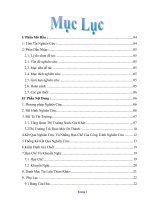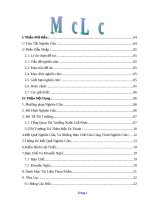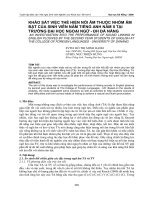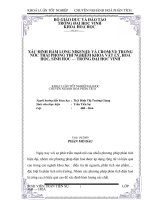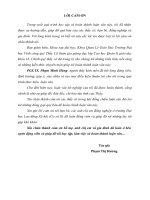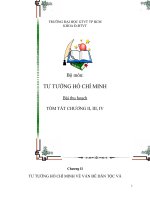Lecture Drama II - Modern drama: Lecture 29 - Dr Irum Zulfiqar - Trường Đại học Công nghiệp Thực phẩm Tp. Hồ Chí Minh
Bạn đang xem bản rút gọn của tài liệu. Xem và tải ngay bản đầy đủ của tài liệu tại đây (419.62 KB, 10 trang )
<span class='text_page_counter'>(1)</span><div class='page_container' data-page=1>
DRAMA II
Modern Drama | An
OVERVIEW
</div>
<span class='text_page_counter'>(2)</span><div class='page_container' data-page=2>
SYNOPSIS
</div>
<span class='text_page_counter'>(3)</span><div class='page_container' data-page=3>
Functions and
Characteristics of Modern
Drama
mirrors the complex struggle of life
the inspiration is to seek truth
either to become part of the process or
be left behind
This is the social significance which
differentiates modern dramatic art from
art for art’s sake.
It is the dynamite which undermines
superstition, shakes the social pillars, and
prepares men and women for the
reconstruction.
</div>
<span class='text_page_counter'>(4)</span><div class='page_container' data-page=4>
The Role of Scandinavian Drama
“The State is the curse of the individual.
How has the national strength of Prussia
been purchased? By the sinking of the
individual in a political and geographical
formula... The State must go! That will
be a revolution which will find me on its
side. Undermine the idea of the State,
set up in its place spontaneous action,
and the idea that spiritual relationship is
the only thing that makes for unity, and
you will start the elements of a liberty
which will be something worth
possessing.”
(Henrik Ibsen )
</div>
<span class='text_page_counter'>(5)</span><div class='page_container' data-page=5>
Ibsen’s Work
What Writer’s Have Said About Henrik Ibsen:
“All of Ibsen is <sub>visionary drama</sub>… His
mastery of <sub>inwardness</sub> is second only to
Shakespeare’s.” — Harold Bloom
“Had the <sub>gospel of </sub>Ibsen been <sub>understood</sub>
and <sub>heeded</sub>, these <sub>fifteen millions </sub>might
have been alive now.” — George
Bernard Shaw (Discussing the loss of life
during World War I)
“His characters may hate one another or
be happy together, but they will <sub>generate </sub>
</div>
<span class='text_page_counter'>(6)</span><div class='page_container' data-page=6>
II. Characters and
Characterization
1. Nora –
. The protagonist of the play and the wife
of Torvald Helmer.
. a playful, naïve child who lacks
knowledge of the world outside her
home
. not as innocent or happy as she
appears.
. In the end she finds her position in her
</div>
<span class='text_page_counter'>(7)</span><div class='page_container' data-page=7>
2. Torvald Helmer –
Nora’s husband.
Torvald delights in his new position at
the bank, just as he delights in his
position of authority as a husband.
He treats Nora like a child, in a manner
that is both kind and patronizing.
He does not view Nora as an equal but
rather as a plaything or doll to be teased
and admired.
In general, Torvald is overly concerned
with his place and status in society, and
he allows his emotions to be swayed
heavily by the prospect of society’s
</div>
<span class='text_page_counter'>(8)</span><div class='page_container' data-page=8>
3. Krogstad –
A lawyer who went to school with Torvald
and holds a subordinate position at
Torvald’s bank.
Krogstad’s character is contradictory:
though his bad deeds seem to stem from
a desire to protect his children from
scorn, he is perfectly willing to use
unethical tactics to achieve his goals.
His willingness to allow Nora to suffer is
despicable, but his claims to feel
sympathy for her and the hard
</div>
<span class='text_page_counter'>(9)</span><div class='page_container' data-page=9>
4. Mrs. Linde –
Nora’s childhood friend.
Kristine Linde is a practical,
down-to-earth woman, and her sensible
worldview highlights Nora’s somewhat
childlike outlook on life.
Mrs. Linde’s account of her life of
poverty underscores the privileged
nature of the life that Nora leads.
we also learn that Mrs. Linde took
responsibility for her sick parent,
whereas Nora abandoned her father
when he was ill.
5. Dr. Rank –
Torvald’s best friend.
Dr. Rank stands out as the one character
in the play who is by and large
unconcerned with what others think of
him.
He is also notable for his stoic
acceptance of his fate.
Unlike Torvald and Nora, Dr. Rank admits
to the diseased nature (literally, in his
case) of his life.
For the most part, he avoids talking to
Torvald about his imminent death out of
respect for Torvald’s distaste for
</div>
<span class='text_page_counter'>(10)</span><div class='page_container' data-page=10>
6. Bob, Emmy, and Ivar
–
Nora and Torvald’s
three small children.
In her brief interaction
with her children, Nora
shows herself to be a
loving mother.
When she later refuses
to spend time with her
children because she
fears she may morally
corrupt them
7. AnneMarie
–
The Helmers’ nanny.
Though Ibsen doesn’t
fully develop her
character, Anne-Marie
seems to be a kindly
woman who has
genuine affection for
Nora.
She had to give up her
own daughter in order
to take the nursing job
offered by Nora’s father.
Thus, she shares with
Nora and Mrs. Linde the
act of sacrificing her
</div>
<!--links-->
